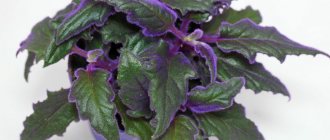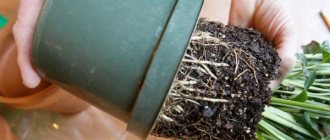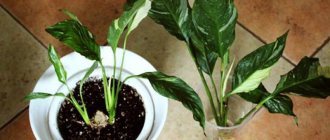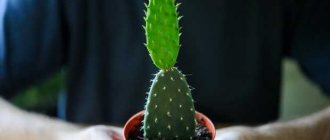There, a delicate flower grows in mountainous areas near waterfalls and reproduces by self-sowing.
But in indoor conditions, propagation of violets will require the participation of a grower.
Reproduction at home
There are several simple ways to propagate violets, which have long been used by gardeners. They are simple and very effective, vegetative propagation methods are especially popular:
- cuttings;
- children;
- dividing the bush.
The choice of a specific technique depends on the time of year and age of the mother specimen, its varietal characteristics . However, if the goal is to obtain a large number of young specimens, they resort to the generative method - sowing seeds.
General rules
To get healthy offspring, you should adhere to a number of important agrotechnical rules.
They concern not only the timing of reproduction, but also the creation of a favorable microclimate for the parent specimen and young violets . Therefore, in order to get an idea of how to propagate violets, you need to find out the main rules for caring for the plant.
What time of year is it best to propagate Saintpaulias?
Thanks to artificial lighting, cultivation of Saintpaulias is possible throughout the year.
But the optimal timing still occurs in spring and summer , when violets receive sufficient heat and light and are actively vegetating. In the fall, they are already preparing for a period of rest - rooting may not be successful.
Humidity level
Violet does well indoors. But the air should not be too dry. If the humidity is below 50-60%, it will be much more difficult to successfully propagate the flower.
Temperature
Intensive root formation occurs at a temperature of 26-28 °C. When the temperature drops below 20 °C, photosynthesis processes slow down, rooting occurs much more slowly, and the development of the vegetative mass is delayed.
A simpler way
You shouldn't rummage through the leaves if you don't need the stepson intact. You can first cut off the leaves of the stepson, and then only the stumps of its cuttings will be visible. With good visual visibility and open, unobstructed access, retrieving them is a piece of cake.
Here is my violet after getting rid of it:
The first time after the transformation, the violet may look bald. But time will pass - and all the leaves will fall into place!
I in no way wanted to say that stepchildren are absolute evil. But I carefully look out for each one and... immediately delete it! I like flat violets with a bouquet. But I fully admit that other gardeners like bush violets.
Do you remove the stepsons from your violets? Let's share opinions, experiences, results.
Which plants to choose
Propagation material is taken from violets of any age. However, for a young mother specimen such a procedure will be painful, while for older specimens there is already a small supply of nutrients for successful rooting. It is better to choose plants aged 2-3 years.
If the bush is old with a powerful root system, it can be propagated by dividing the bush. In addition, such specimens may already have formed lateral rosettes, which are also suitable for producing new plants.
You should avoid using young Saintpaulias as a mother plant , giving them the opportunity to build up root and vegetative masses and accumulate maximum vitality.
What soil to choose for young Uzambara violet
For successful growth, violets require a light and loose soil mixture with excellent breathability. The best option is a substrate based on high-moor peat with the addition of perlite, vermiculite or polystyrene foam.
As an alternative, take sphagnum moss or peat tablets; violet roots also develop very well in them . Peat tablets must be soaked before use as indicated in the instructions.
Pot or glass? What is better and how to correctly determine the right size
To root cuttings or parts of the stem, use cups with a diameter of 5-6 cm. There should be drainage holes at the bottom to drain excess water. It is permissible to use plastic cups and yogurt containers, making holes in them yourself.
When dividing a bush, take a container with a slightly larger diameter than the root system of the planting material.
If you use a container that is too large, the soil that has not been developed by the roots will begin to sour, become compacted, and will no longer allow air to pass through to the underground part of the violet.
In what cases are greenhouses and moss needed?
To stimulate rooting, greenhouses are used, regardless of the chosen propagation method. Their installation makes it possible to create an optimal microclimate for the development of the root system of young flowers.
Moss also speeds up the root formation process by maintaining a high level of soil moisture . In this case, there is no danger that the soil mixture will sour.
Note! Not all varieties of violets reproduce in this way. For example, “Raisin” and “Chimera” violets may not retain their varietal characteristics. And the varieties of violets “Dance of Galaxies” and “Ice Rose” will most likely be preserved.
Do leaves always give roots?
No, sometimes they rot without ever taking root.
100%
Always, 100% of leaves give roots
0%
I constantly struggle with leaves, roots appear on 2-3 out of 10
0%
Voted: 4
Violet trailers
This type of Saintpaulia is also called ampelous . Unlike ordinary violets, they have not one growing point, but several. The growth of stepchildren on trailers is only welcome , since at their expense a lush bush is formed.
To speed up this process, on each branch, after 2-3 tiers of leaves, a growth point is plucked out.
Violet trailer "Rondita".
How to stimulate and speed up rooting
Two main techniques to speed up root formation still have the right to exist today. The first method involves the use of special drugs - growth stimulants . They are used to treat the cut site (in the case of propagation by leaf) or the roots of the division (in the case of propagation by dividing the bush).
The second way is to organize a mini-greenhouse . It is used as a film with a frame or a cut plastic bottle. Due to high humidity and temperature, root formation accelerates.
Recently, agrofibre has become popular; it can also be used to create a greenhouse environment. The canvas is much more durable than film, it is more durable.
Propagation of violets by leaf fragments
It happens that the leg of the leaf breaks off or the leaf plate itself begins to deteriorate. It doesn’t matter – you can grow a violet even from a small fraction of a leaf.
To do this, you need to cut the sheet correctly. Be sure to remove all rotting and damaged parts to healthy materials, using a knife with a disinfected sharp blade. All cut lines must pass between the lateral veins without damaging them. Since the lateral veins will subsequently feed the children.
There are the following methods for obtaining leaf fragments:
- The sheet is cut crosswise. In this case, 4 fragments are obtained: body, upper and two lateral. If you need to increase the amount of planting material, you can divide these fragments into even smaller parts. The main thing is that in each of them at least one side vein is intact.
- The method is used in the absence of a petiole. Then a fake petiole about 1 cm long is cut out from the central vein of the leaf plate. It is planted in soil or moss, just as when planting a regular Saintpaulia leaf cutting.
- If the leaf does not have a petiole, then you can plant it in its original form, without bothering with cutting anything out. They simply bury the bottom of the leaf into the ground and wait for the babies. You can also peel off the cut top or bottom halves of the sheet.
- The leaf is cut in a circle to save space in the greenhouse or to remove rotten edges.
The resulting leaf fragments are buried with the body edge into the soil or moss. And they put the pots in the greenhouse.
This is how full-fledged children grow from fragments of a violet leaf
How to cut a leaf to obtain fragments and how to plant these fragments in the ground - all this is explained in the video:
How to use cytokinin paste when propagating Saintpaulia
The product is used to produce babies from cuttings. The paste is applied with a needle into a scratch made on the petiole near the surface of the earth in a glass. Literally after 10-14 days, intensive formation of children begins , which must be placed in a timely manner.
Stepchildren of violets
Reasons for education
There are several reasons for the formation of shoots in violets:
- Genetic predisposition - some varieties of violets are characterized by the constant growth of young rosettes;
- Almost all Saintpaulias begin to produce nascent rosettes after transplantation , since fresh soil is usually rich in nitrogen. Subsequently, until the next transplant, the violet stops producing young rosettes;
- Overfeeding the plant with nitrogen fertilizer;
- Violets contained in wick or hydroponic irrigation – the nutrient solution always contains fertilizers;
Stepchildren often form in violets when watered with wicks. - is too large ;
- When the growth point is injured , several tops of Saintpaulia begin to grow at once;
- When Saintpaulia gets sick or is damaged by pests , the dying plant strives to continue itself.
Do stepchildren need to be removed? If you do not plan to propagate the variety, then they must be removed. They draw nutrients onto themselves , and this damages flowering. The thickening of the mother plant and deformation of its trunk and crown also occur
Since flowering in violets begins in the spring after transplantation, young rosettes begin to grow simultaneously with peduncles. In order for the flowers to get more strength and nutrition, they must be removed, preferably at an early stage.
While the rosette that is starting to grow is still tiny, it can be peeled off with an ordinary toothpick, the tip of a scalpel, tweezers or nail scissors. When the moment is missed and the rosette has reached a larger size, 3-4 cm, then this can be done with a sharp knife, scalpel or plucked off with your fingers.
Before the procedure, instruments must be disinfected, and then sprinkle the wound with activated carbon.
Important! There should be no stumps from stepsons left in the leaf axil.
You need to make it a rule that every watering you carefully inspect the violets for the formation of young rosettes and immediately remove them.
The sooner this is done, the less Saintpaulia is injured.
Removal promotes the formation of an even, symmetrical rosette with one growth point .
Differences from peduncles
Before removal, you need to know how to identify stepsons and learn to distinguish nascent peduncles from emerging young rosettes. This is complicated by the fact that both appear from the leaf axil. The first thing that can be distinguished is 2 small leaves.
The stepson and the peduncle have different shapes:
- the peduncle has pointed, lanceolate leaves called stipules;
- The stepson has rounded leaves .
If you have doubts about identification, you need to wait a little. After some time, a bud will appear between the stipules - it is difficult to confuse it with a growing rosette.
Photo of stepsons and peduncle.
Sometimes, by mistake or ignorance, stepchildren are called children. It is not right:
- stepsons grow from the axils of the leaf blades of an adult violet;
- young rosettes growing from a planted cutting, peduncle or leaf blade are called babies.
Saintpaulia babies are independent small plants that have their own root system.
Reproduction
As a rule, in order not to spoil the Saintpaulia rosette and not cause damage to its flowering, propagation is carried out by cuttings. Moreover, from one cutting you can get 4-6 children, and from rooting a leaf plate up to 20, or even more.
The problem is that such methods do not always convey the varietal characteristics of fancy varieties of violets and chimeras. The latter, in order to preserve the original properties, are propagated either by peduncles or by stepsons. It should be noted that these particular types of violets grow them quite rarely.
Attention! Fancy Saintpaulias and chimeras retain their varietal qualities as much as possible only when propagated by stepsons. But even in this case, there is no 100% guarantee that the flower will retain the colors of the mother plant.
Often, wanting to get more young rosettes, chimeras and fantasy varieties are subjected to the following procedures:
- The growing point is removed . At the same time, the number of stepchildren increases sharply;
- When the rosette is mature enough, when transplanting the violet, the crown is cut off , leaving a stem stump with 1-2 rows of leaves. The crown is rooted separately, and the lower part can produce up to 10 new violets;
- They do not allow Saintpaulia to bloom , that is, they remove not the shoots, but the peduncles and feed them with fertilizers with a preponderance of nitrogen. True, you need to be extremely careful with nitrogen fertilizers, as this can weaken the plant’s immunity.
In order for the newborn rosette to take root well, it is allowed to grow. The height of the very first leaves should be at least 4 cm . To separate a young rosette from the mother plant, it is best to use a scalpel, but you can use a stationery knife with a narrow blade or a razor. Before surgery, the blade must be disinfected.
The operation itself, like taking a shoot from a violet , consists of the following stages:
- Determine which leaves belong to an adult rosette and which are young;
- Gently holding the emerging rosette with your left hand and lifting the leaf plate of the mother rosette, use a scalpel to carefully press on the base of the stepson, separating it;
- If some of the leaves are damaged, they must be removed before planting.
Rooting stepchildren occurs in the same way as rooting cuttings:
- in water;
- in the ground;
- in sphagnum moss;
- in perlite or vermiculite.
Rooting in sphagnum moss.
Carefully! Rooting in water is not recommended, since the stem is still very small and there is a possibility of flooding of the growing point, after which the small rosette may rot.
Experienced collectors most often root stepsons in damp sphagnum moss, covering the container with a plastic bag. It must be removed every 2 days to ventilate the plant.
The advantage of this method is that sphagnum is a natural antiseptic and roots appear in 10-14 days . After this, the rosette is transplanted into the ground.
The main conditions for growing the root system are:
- constant temperature not lower than 22°C;
- minimal daily temperature fluctuations;
- constant humidity.
The amount of lighting does not really affect the formation of roots, therefore, the greenhouse can simply be placed in a well-lit place , but in no case on the windowsill - day/night temperature changes can lead to the death of the stepson.
Advantages of violet propagation by stepsons:
- Preservation of varietal characteristics of Saintpaulia;
- From the rooting of the leaf blade to the flowering of Saintpaulia, much more time passes than when planting a stepson;
- Guaranteed survival of a young socket.
But on the other hand, the growth of stepchildren negatively affects the appearance and flowering of the mother plant.
How to care for older children
Aftercare is quite simple. It comes down to simple steps:
- Watering - abundant moisture is required only for the first time. Then they make sure that the earthen ball does not dry out. The optimal method of watering is bottom (from a tray). The main thing is to prevent drops from getting on the leaves.
- Feeding - during the active growing season, feed with liquid complex fertilizers for flowering crops in half the dosage. Frequency of use: every decade.
- Protection from diseases and pests - violets have strong immunity. It is important not to over-moisten the soil, which can lead to the development of gray rot. The roots begin to rot, and over time the violet dies. Dry air is also dangerous, causing spider mites to colonize shoots. To combat the latter, insecticidal preparations are used.
- Transplantation - young plants are transplanted into slightly larger containers every spring to ensure lush flowering.
How to delete
The sooner, the better and easier. But, if you notice the stepsons that have just hatched, I suggest you wait and make sure that this is not a peduncle. At first it can be confusing.
It’s better not to rush, but to clearly understand where the trunk is and where the stepson is. For example, look at the photo taken during the process:
The process of removing stepsons from a violet
At first it seems that nothing is clear. But, looking closely, you can see the body of the stepson-hanger-on:
Highlighted stepson violet color
Now there are 2 ways to rid the violet of the stepson.
Is it possible to grow Saintpaulias on a windowsill?
At home, violets are grown on windowsills. For the successful growth and development of young violets, it is enough to provide a good level of lighting: in winter, containers are placed near windows with a southern orientation, and in other periods - eastern or western .
To prevent young violets from being hot or cold, they are placed in mini-greenhouses where a stable temperature and humidity regime is maintained. The windows near the flower are not opened for ventilation to avoid drafts.
After successful rooting, the greenhouse is removed, and apartment conditions are suitable for adult plants (humidity - 50%, temperature - 22 °C).
What methods to use for varietal Saintpaulias
The seed propagation method is not only a labor-intensive process: even after successful artificial pollination, the formation of seed pods and the collection of seed material, the method will not give the expected results when growing varietal flowers. The resulting seedlings do not retain the varietal characteristics of the parent specimen.
This can be avoided by using vegetative techniques. Any method is suitable, from cuttings, propagation by rosettes and to dividing the bush. The exception is the chimera violet. In this case, the apical propagation method is used.
Dividing the bush
This method is suitable for all violets, since with it they do not lose their varietal characteristics. You can divide a bush during spring replanting with a large number of shoots.
In this case, those shoots that already have their own roots are separated.
The rosettes cut off in this way, with their roots, are placed in separate containers.
Care in this case is similar to care for adult plants with maintaining moisture, heat and lighting.
When planting in new pots, you can use a special mixture for adult individuals. You can purchase it at any specialized store.
Advice from experienced flower growers
Propagation of violets is a painstaking but fascinating process. If you follow all the rules, the florist can easily preserve the varietal qualities, receiving many young, lushly blooming violets.
Are you looking for an answer to the question why violets don’t bloom? Perhaps they are affected by some kind of disease or pests are bothering them.











